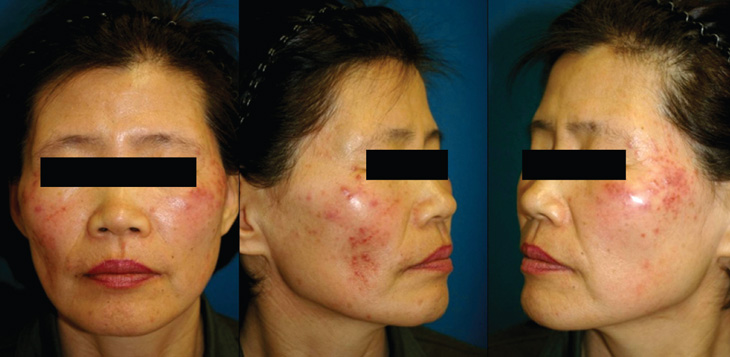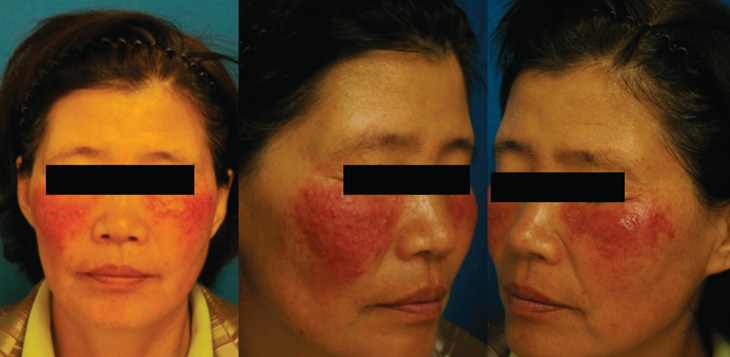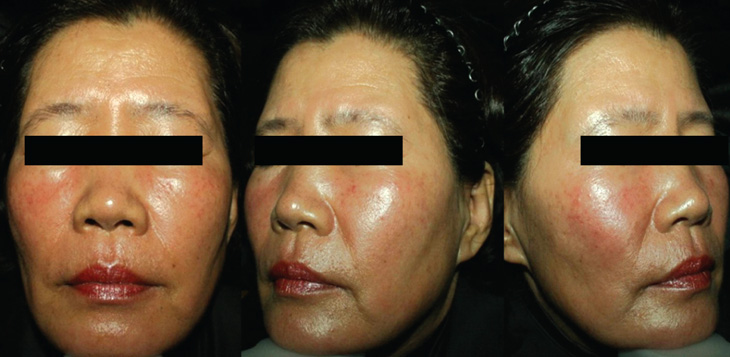J Korean Med Sci.
2011 May;26(5):694-696. 10.3346/jkms.2011.26.5.694.
Oral Azithromycin for Treatment of Intractable Rosacea
- Affiliations
-
- 1Department of Dermatology, Yonsei University Wonju College of Medicine, Wonju, Korea. choieh@yonsei.ac.kr
- KMID: 1777873
- DOI: http://doi.org/10.3346/jkms.2011.26.5.694
Abstract
- Rosacea is a common chronic cutaneous disorder that primarily occurs on the convex surfaces of the central face and is often characterized by exacerbations and remissions. A case of a 52-yr-old woman visited our clinic in February 2008 complaining typical features of rosacea including multiple pinhead to rice-sized erythematous papules. We applied various conventional treatments including topical benzoyl peroxide and metronidazole as well as oral metronidazole, isotretinoin, and doxycycline. The lesions were not controlled but were rather aggravated by complications from these treatments. Therefore, we prescribed oral azithromycin, which has anti-inflammatory effects and reduces reactive oxygen species. Ten weeks after the administration of oral azithromycin, 500 mg per day for 2 weeks, the lesions had mostly disappeared and no specific side effects related to the azithromycin were noted. Oral azithromycin dosing 500 mg/day for 2 weeks is effective for treatment of intractable rosacea.
Keyword
MeSH Terms
Figure
Reference
-
1. Modi S, Harting M, Rosen T. Azithromycin as an alternative rosacea therapy when tetracyclines prove problematic. J Drugs Dermatol. 2008. 7:898–899.2. James WD, Berger TG, Elston DM. Andrew's diseases of the skin. 2006. 10th ed. Philadelphia: WB Sauders;245–349.3. Del Rosso JQ. Systemic therapy for rosacea: focus on oral antibiotic therapy and safety. Cutis. 2000. 66:4 Suppl. 7–15.4. Bakar O, Demirçay Z, Gürbüz O. Therapeutic potential of azithromycin in rosacea. Int J Dermatol. 2004. 43:151–154.5. Fernandez-Obregon A. Oral use of azithromycin for the treatment of acne rosacea. Arch Dermatol. 2004. 140:489–490.6. Fernandez-Obregon A, Patton DL. The role of Chlamydia pneumoniae in the etiology of acne rosacea: response to the use of oral azithromycin. Cutis. 2007. 79:163–167.7. Bakar O, Demirçay Z, Yuksel M, Haklar G, Sanisoglu Y. The effect of azithromycin on reactive oxygen species in rosacea. Clin Exp Dermatol. 2007. 32:197–200.8. Jones D. Reactive oxygen species and rosacea. Cutis. 2004. 74:3 Suppl. 17–20.9. Humbert P, Treffel P, Chapuis JF, Buchet S, Derancourt C, Agache P. The tetracyclines in dermatology. J Am Acad Dermatol. 1991. 25:691–697.10. Bannatyne RM. Metronidazole, its bioactive metabolites and acne. Curr Med Res Opin. 1999. 15:298–299.11. Labro MT. Anti-inflammatory activity of macrolides: a new therapeutic potential? J Antimicrob Chemother. 1998. 41:Suppl B. 37–46.12. McDonald PJ, Pruul H. Phagocyte uptake and transport of azithromycin. Eur J Clin Microbiol Infect Dis. 1991. 10:828–833.13. Scaglione F, Rossoni G. Comparative anti-inflammatory effects of roxithromycin, azithromycin and clarithromycin. J Antimicrob Chemother. 1998. 41:Suppl B. 47–50.14. Alvarez-Elcoro S, Enzler MJ. The macrolides: erythromycin, clarithromycin, and azithromycin. Mayo Clin Proc. 1999. 74:613–634.15. Akhyani M, Ehsani AH, Ghiasi M, Jafari AK. Comparison of efficacy of azithromycin vs. doxycycline in the treatment of rosacea: a randomized open clinical trial. Int J Dermatol. 2008. 47:284–288.16. Torresani C. Clarithromycin: a new perspective in rosacea treatment. Int J Dermatol. 1998. 37:347–349.17. Dereli T, Inanir I, Kilinç I, Gençoğlan G. Azithromycin in the treatment of papulopustular rosacea. J Dermatol. 2005. 32:926–928.
- Full Text Links
- Actions
-
Cited
- CITED
-
- Close
- Share
- Similar articles
-
- Maintenance of Remission after Oral Metronidazole Add-on Therapy in Rosacea Treatment: A Retrospective, Comparative Study
- A Case of Ocular Rosacea Treated with Oral Tetracycline
- Pulsed Dye Laser Treatment Combined with Oral Minocycline Reduces Recurrence Rate of Rosacea
- The Effect of Azithromycin on the Cyclosporin- Ainduced Gingival Fibroblast Overgrowth
- Effect of azithromycin on gingival overgrowth of organic transplanted patients




